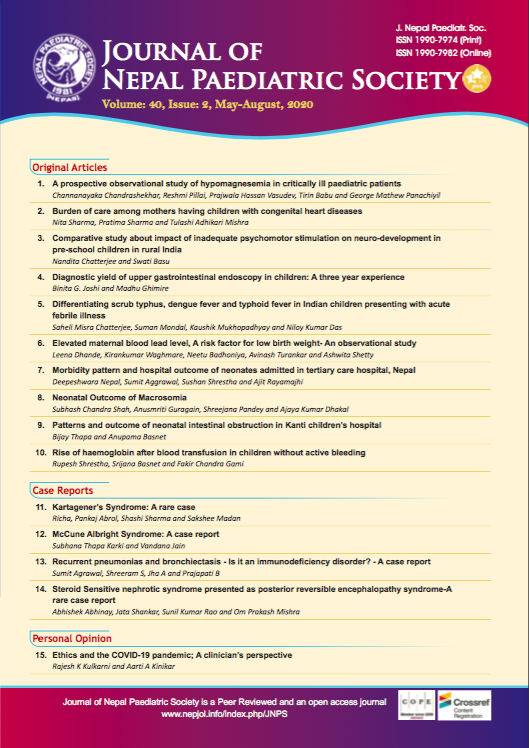Patterns and Outcome of Neonatal Intestinal Obstruction in Kanti Children’s Hospital
DOI:
https://doi.org/10.3126/jnps.v40i2.29254Keywords:
Anorectal malformation, Hirschprung's disease, Intestinal obstruction, Meconium ileusAbstract
Introduction: Neonatal intestinal obstruction is the most common neonatal surgical emergency. More than 75% of neonatal surgeries are done for the correction of this problem. The outcome of this obstruction mainly depends upon the causes of obstruction, clinical condition of the patient, associated anomalies, expertise and centre where the patient is dealt. This study was undertaken to study the clinical features and outcome of neonatal intestinal obstruction presented in our centre.
Methods: The medical records of all neonates admitted in the surgical NICU were selected and cases with the diagnosis of neonatal intestinal obstruction and managed surgically during two years period from September 1, 2015 to September 1, 2017 were retrospectively reviewed and analysed in regard to age at presentation, sex, weight, gestation, postoperative diagnosis and their outcome.
Results: Out of 235 admitted neonates, 205 cases were treated surgically for intestinal obstruction. There were a total of 154 (75.2%) males and 51 (24.8%) females. Mean age at presentation was 4.5 days and average weight was 2.25 kg. Among them, anorectal malformation (ARM) 88 (42.92%), intestinal atresia 59 (28.78%), Hirschsprung’s disease 38 (18.53%), malrotation of gut 10 (4.87%) and meconium ileus 10 (4.87%) were the etiology. Among intestinal atresia, duodenal atresia 27 (45.76%) was the commonest one followed by ileal atresia 24 (40.67%), six jejunal atresia (10.16%) and two colonic atresia (3.38%). Overall, 160 neonates survived (78.04%). Among the survival, Hirschsprung’s disease was 34 (89.47%), ARM 78 (88.63%), seven malrotation of gut (70%), six meconium ileus (60%) and intestinal atresia 35 (59.32%).
Conclusion: Neonatal intestinal obstruction is the most common neonatal surgical emergency in Kanti Children’s Hospital. Anorectal malformation was the commonest etiology followed by intestinal atresia and Hirschsprung’s disease. Overall survival rate was 78%. Cases with Hirschsprung’s disease and anorectal malformation had about 90% survival rate. Intestinal atresia was the major cause of mortality occupying 53.35% of total mortality of 21.95%. Mortality is mainly due to delayed diagnosis, referral and intervention which lead to higher complications of cases.
Downloads
Downloads
Published
How to Cite
Issue
Section
License
Authors who publish with this journal agree to the following terms:
Authors retain copyright and grant the journal right of first publication with the work simultaneously licensed under a Creative Commons Attribution License that allows others to share the work with an acknowledgement of the work's authorship and initial publication in this journal.
Authors are able to enter into separate, additional contractual arrangements for the non-exclusive distribution of the journal's published version of the work (e.g., post it to an institutional repository or publish it in a book), with an acknowledgement of its initial publication in this journal.
Authors are permitted and encouraged to post their work online (e.g., in institutional repositories or on their website) prior to and during the submission process, as it can lead to productive exchanges, as well as earlier and greater citation of published work (See The Effect of Open Access).



